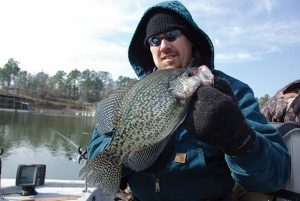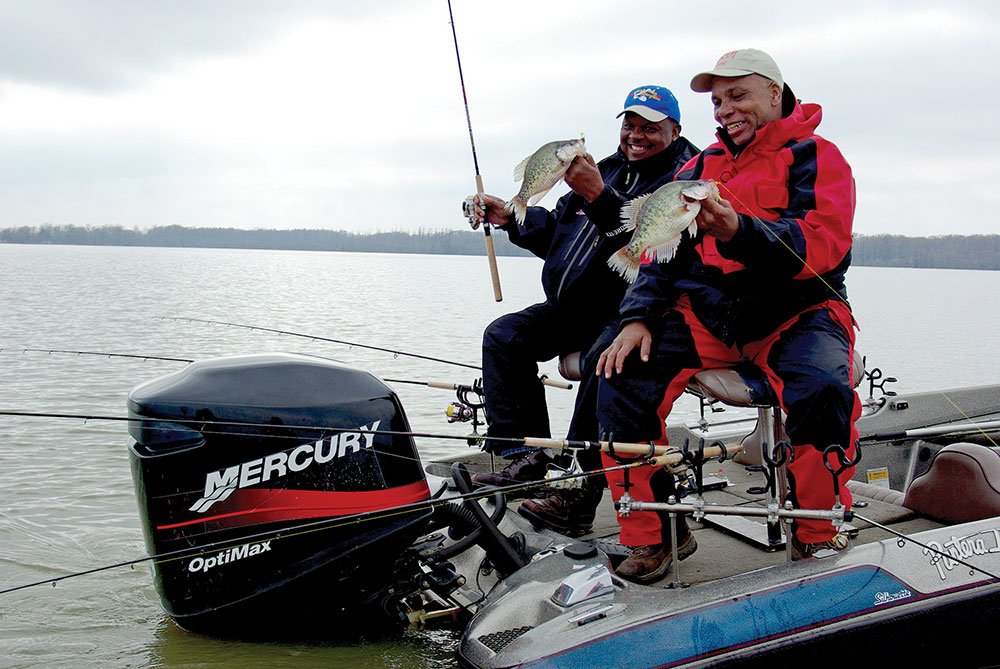By Keith “Catfish” Sutton
(Photo above: Mississippi anglers Don Jackson (left) and Bernard Williams use an innovative trolling tactic they call “wildcatting” to catch these nice winter crappie.)
For those hardy anglers who can abide the cold, wind, rain and snow often seen in November and December, this season provides superb opportunities for hooking lots of big crappie. Unfortunately, though, many cold-weather crappie outings end in failure. Why? Mainly because anglers insist on using spring spawning season methods, and those methods rarely lure ice-water slabs. To be successful, anglers need to know specific tactics for catching winter’s fussy fish.
Toward that end, here are tips from some of America’s top crappie anglers that can make your winter catch rate soar. Use them and enjoy the bounty.
Glowing Jigs for Muddy-Water Slabs
Mississippi crappie guide Brad Chappell often finds his favorite crappie lakes high and muddy in winter.
“During this time, I often use a large bait that glows: a 1/8-ounce Bobby Garland Mo’Glo jighead with a Mo’Glo Stroll’R jig tied with a basic loop knot,” Chappell said. “I clamp a 3/16-ounce bullet weight with two round split shot 18 inches above the jig. I slow-troll this rig in upper parts of the water column. The lure’s action and glow help crappie locate and attack it even when visibility is limited.”
Winter Wildcatting
Bernard Williams and Don Terry of Jackson, Miss. use their wildcat trolling technique to trigger crappie bites when the water gets cold.
“Using a combination of jigs and minnows, I use my trolling pattern to trigger strikes,” Williams said. “I make large ovals with my boat as I troll. This raises and speeds up the outside baits, while lowering and slowing down the inside baits. I’ve seen this work consistently when other fishermen around me weren’t getting any strikes.
“Whether spider-rigging or long-lining, I never follow a straight path,” he continued. “This gives me an idea of what speed the crappie want the baits traveling. If that doesn’t work, sometimes I will turn the trolling motor completely off, wait about 10 seconds and then take back off at the speed I was moving before I turned the motor off.”
Dress for the Weather … and Safety
Tennessee crappie pro Ronnie Capps says it’s important for crappie anglers to dress appropriately for winter comfort if they want to be successful.
 “Always dress with more clothing than you think you will need,” Capps said. “Chest waders and waterfowl gear are not too extreme. Keep your body warm and dry. I use both extreme chest waders and Army-surplus inflatable flight boots for keeping my feet warm.”
“Always dress with more clothing than you think you will need,” Capps said. “Chest waders and waterfowl gear are not too extreme. Keep your body warm and dry. I use both extreme chest waders and Army-surplus inflatable flight boots for keeping my feet warm.”
Capps notes that wearing a trustworthy PFD (personal flotation device) also is a must. “An inflatable PFD provides the most comfort while fishing,” he said. “Just be double sure the cartridge and mechanism are in perfect working order. I know it sounds extreme, but to test your ability to survive a fall overboard on a winter crappie trip, hop into a pool wearing the exact clothing and PFD you would be wearing while fishing. A practice session in your cool pool could save your life and even the life of your fishing partner.”
Adapt for Conditions
Capps’ fishing partner, Steve Coleman of Tiptonville, Tenn., agrees that dressing warmly is a key to enjoying winter crappie-fishing success.
“Dress warm, and take a cooler full of hot water in which to warm your hands,” Coleman said. “Then get ready for some fun. Winter crappie are some of the easiest to catch, especially as the water freezes or thaws. Bright, sunny winter days with no wind can be better than good days during the spring spawn. Just be sure to downsize your bait and line, and slow your presentation to a crawl.”
Oxbow Spider-Rigging
Crappie-fishing fanatic Hugh Krutz of Brandon, Miss., spends most of his winter fishing time on Magnolia State oxbow lakes.
“I like to spider rig out in the middle of these lakes, targeting white crappie,” he said. “On each pole, I use a standard double-minnow rig with 1/2-ounce weights and hooks rigged at least 2 feet apart. I stagger the poles at different depths until I find the exact depth the fish are holding.”
To pinpoint crappie schools, Krutz uses electronics to locate balls of baitfish.
“At times, crappie will be on the bottom in 20-plus feet of water,” he said. “But often as not, they’ll be up feeding on the balls of baitfish. To catch them this season, you have to slow down because the crappie aren’t going to chase the bait like they do in warmer months. It’s also important to match your bait size with the lake’s natural forage. The general rule in winter is slower and smaller.”
(Note: Keith Sutton is the author of “The Crappie Fishing Handbook.” To order an autographed copy, send a check or money order for $19.45 to C & C Outdoor Productions, 15601 Mountain Dr., Alexander, AR 72002.)



